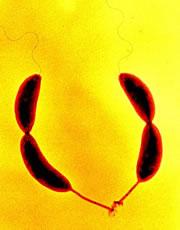 Cauilobacter crescentus is the strongest sticker in nature.Credit: Yves Brun
Cauilobacter crescentus is the strongest sticker in nature.Credit: Yves BrunGeckos, mussels and barnacles step aside - physicists have found the stickiest customer in all of biology. The title-holder is an unassuming bacterium that lives anywhere wet. By copying its feat of strength, material scientists might create new surgical glues.
So secure is the adhesive made by Caulobacter crescentus that the bacterium can cling to a surface even when subjected to a force equivalent to four cars balanced on a coin.
Caulobacter crescentus is usually the first organism to colonize any watery surface, from boat hulls, to water pipes, to medical catheters. And it's notoriously difficult to shift, resisting high-pressure water jets with ease.
But nobody knew just how strong it was, until a team of physicists devised a way to measure the strength of its glue, which is made out of long sugar-based molecules called polysaccharides.
Refusing to budge
The researchers grew individual bacterial cells on the tip of a flexible pipette and used a second pipette to suck the cell from its mooring. By examining the flexible pipette's deflection, they gauged the force needed to dislodge the bacterium's tail-like anchor from the surface.
"It took us several months to get the system working," recalls team member Jay Tang of Brown University in Providence, Rhode Island. "It was a pretty tedious task."
ADVERTISEMENT
Eventually, the researchers worked out that the average C. crescentus requires around 70 newtons per square millimetre to rip it from a surface, a grip about seven times stronger than a gecko's footpad. Commercial 'super' glue gives up at about 25 newtons per square millimetre.
Because the bacterial glue works in the wet, it might find a use as a surgical adhesive, says Tang, who reports the results in Proceedings of the National Academy of Sciences1. It could be produced simply by culturing the bacterium, or biochemists could study its precise composition in a bid to make their own version.
Visit our makesnatures_strong.html">newsblog to read and post comments about this story.
-
References
- Tsang P. H., Li G., Brun Y.V., Freund L. B.& Tang J. X. Proc. Natl Acad. Sci. USA, 103. 5764 - 5768 (2006). | Article |
